In the silent language of the hands lies a powerful key to balance, healing, and inner harmony. Yoga mudras, or symbolic hand gestures, are one of the most subtle yet transformative tools in the yogic tradition.
Practiced for thousands of years in Ayurveda, Tantra, and classical Yoga, these sacred gestures help channel energy within the body, calm the mind, and awaken higher states of consciousness.
Whether you’re seeking better focus, emotional stability, or relief from stress and illness, understanding yoga hand mudras and their benefits can elevate your practice and everyday life. These ancient techniques require no equipment, no space—just your presence and intention.
In this guide, we’ll explore the most powerful yoga mudras, their meanings, images, how to practice them, and the impact they can have on your physical, mental, and spiritual well-being.
What is Yoga Mudra?
Yoga mudras are special hand gestures or positions that help direct the flow of energy in the body. The word “mudra” means “seal” or “gesture” in Sanskrit. These hand movements are used during meditation, breathing practices (pranayama), or even while sitting still to create a deep sense of balance and calm.
Each yoga hand mudra has a specific purpose—like improving focus, boosting energy, or relieving stress.
In simple terms, mudras of yoga are like switches that activate certain healing responses in the body and mind, making your yoga and meditation practice more powerful and effective.
Historical and Scriptural Roots of Yoga Mudras
Mudras of yoga have a rich and sacred history that goes back thousands of years. They are deeply rooted in ancient Indian traditions, including Yoga, Ayurveda, Tantra, and classical dance forms like Bharatanatyam. The earliest references to mudras can be found in Vedic scriptures, where they were used during rituals and prayers to channel spiritual energy.
In yogic texts like the Hatha Yoga Pradipika and Gheranda Samhita, mudras are described as powerful practices that awaken inner energy (Kundalini), seal vital life force (Prana), and support meditation. These texts explain that mudras are not just physical gestures but tools to influence the body, mind, and consciousness.
Across centuries, sages and healers have used mudras as gateways to deeper awareness, healing, and spiritual evolution. Today, they remain a simple yet profound part of the yogic journey—bridging ancient wisdom with modern well-being.
How Mudras in Yoga Work? The Science Behind It
Yoga hand mudras may look like simple hand gestures, but they carry deep yogic and energetic significance. In yoga and mudra practice, these subtle movements serve as powerful tools to influence the mind-body connection and regulate energy flow.
Hands as Energy Maps
In yogic philosophy, the hands are seen as energy maps of the body. Each finger corresponds to one of the five elements:
- Thumb – Fire (Agni)
- Index finger – Air (Vayu)
- Middle finger – Space (Akasha)
- Ring finger – Earth (Prithvi)
- Little finger – Water (Jala)
By bringing these fingers together in specific ways, yoga hand mudras help balance these elements within the body, restoring harmony and improving overall health.
Creating Energy Circuits
When we practice hand mudras of yoga, the fingertips form energetic circuits that direct Prana (life force energy) through the body. Just like flipping a switch, each mudra activates a different system—calming the mind, stimulating digestion, enhancing focus, or supporting healing.
Scientific Perspective
From a modern viewpoint, yoga finger mudras stimulate nerve endings, pressure points, and subtle reflex zones. This sends signals to the brain and endocrine system, promoting better emotional regulation, hormonal balance, and improved organ function—similar to acupressure and neurostimulation techniques.
Simple Yet Powerful
The beauty of hand mudras is that they require no tools or physical effort—just your awareness and intention. Whether you’re meditating, breathing deeply, or sitting quietly, practicing mudras regularly enhances your inner balance and deepens your yoga journey.
Types of Yoga Mudras and Their Benefits
The list below shows the yoga mudras and their benefits:
| Mudra Name | Meaning / Gesture | Primary Purpose | Key Benefits |
| Gyan Mudra | Mudra of Knowledge | Enhances focus and wisdom | Boosts memory, reduces stress, aids meditation |
| Prana Mudra | Mudra of Life Force | Activates Prana (vital energy) | Increases energy, boosts immunity, reduces fatigue |
| Apana Mudra | Mudra of Elimination | Detoxification and digestion support | Aids digestion, relieves constipation |
| Vayu Mudra | Mudra of Air Element | Balances excess air in the body | Eases joint pain, reduces anxiety and restlessness |
| Surya Mudra | Mudra of Fire Element | Increases internal heat and metabolism | Helps in weight loss, boosts digestion |
| Varun Mudra | Mudra of Water Element | Hydrates and nourishes the skin | Improves skin health, prevents dryness |
| Shunya Mudra | Mudra of Emptiness / Ether | Reduces space element | Eases ear pain, vertigo, and numbness |
| Dhyana Mudra | Mudra of Meditation | Deepens meditation and inner focus | Brings calmness, enhances concentration |
| Anjali Mudra | Gesture of Prayer / Reverence | Centering and grounding | Cultivates gratitude, humility, and balance |
| Hridaya Mudra | Mudra of the Heart | Opens the emotional heart center | Relieves emotional pain, supports heart health |
| Brahma Mudra | Mudra of Divine Union | Balances throat and nervous system | Reduces tension, supports voice and communication |
| Ling Mudra | Mudra of Heat and Strength | Increases body heat and immunity | Fights cold, strengthens lungs |
1. Gyan Mudra (Mudra of Knowledge)
Gyan means knowledge or wisdom. Gyan Mudra is one of the most basic yoga mudras, used commonly in meditation to enhance mental clarity and awareness.
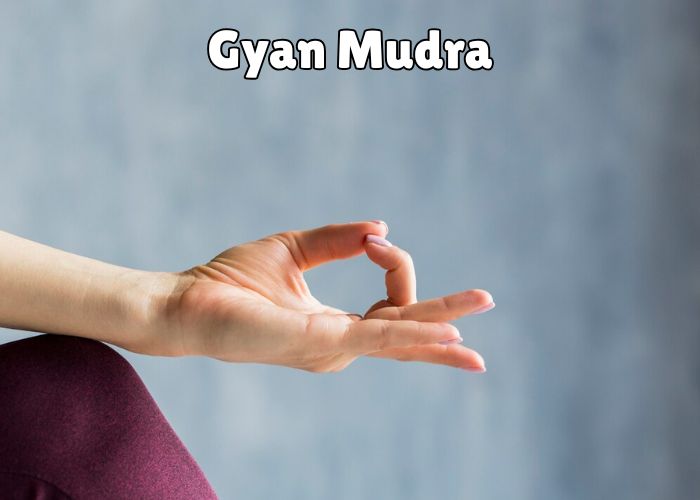
How to Do Gyan Mudra of Yoga?
- Sit in a comfortable position with your spine straight.
- Gently touch the tip of your index finger to the tip of your thumb.
- Keep the other three fingers relaxed and extended.
- Rest the back of your hands on your knees with palms facing upward.
Benefits of Gyan Mudra
- Improves concentration and focus
- Reduces stress and anxiety
- Enhances memory and learning
- Stimulates the brain and nervous system
This is one of the foundational mudras of yoga, suitable for beginners and advanced practitioners alike.
2. Prana Mudra (Mudra of Vital Energy)
Prana means life force. Hence, prana mudra pose activates the body’s energy and strengthens immunity.
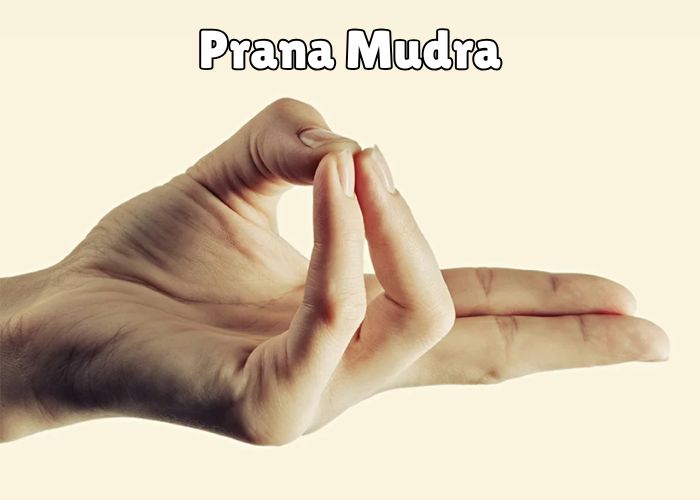
How to Do Prana Mudra of Yoga?
- Join the tips of the ring finger and little finger with the tip of the thumb.
- Keep the other two fingers extended.
- Practice with both hands, palms facing up on your thighs.
Benefits of Prana Mudra
- Boosts energy and vitality
- Strengthens the immune system
- Reduces fatigue and low mood
- Activates dormant energy centers
Among the most common yoga mudras, this one is ideal for anyone needing an energy lift during the day.
3. Varun Mudra (Mudra of Water Element)
Varun represents the water element in the body. It helps in maintaining fluid balance and hydrating the skin.
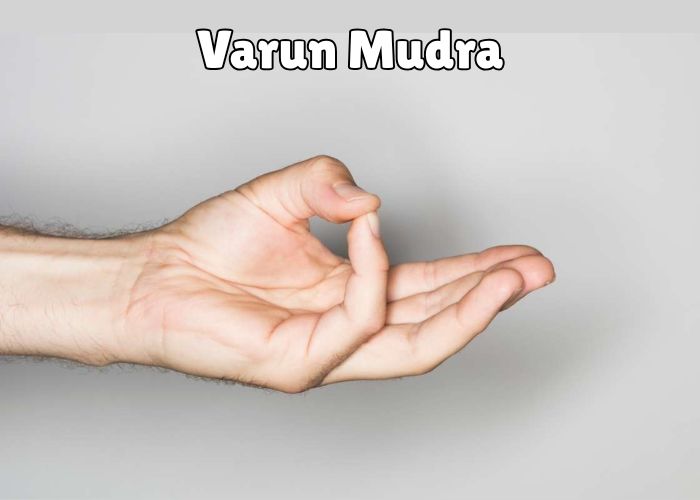
How to Do Varun Mudra of Yoga?
- Lightly touch the tip of the little finger to the tip of the thumb.
- Keep other fingers relaxed and straight.
- Practice it while sitting or even lying down.
Benefits of Varun Mudra
- Keeps the skin soft and glowing
- Prevents dryness and dehydration
- Supports joint lubrication
- Balances water content in the body
This is generally recommended as one of the yoga mudras for sleep due to its calming and cooling effect on the nervous system.
4. Surya Mudra (Mudra of Fire Element)
Surya means sun. This mudra helps increase internal heat and aids in digestion and metabolism.
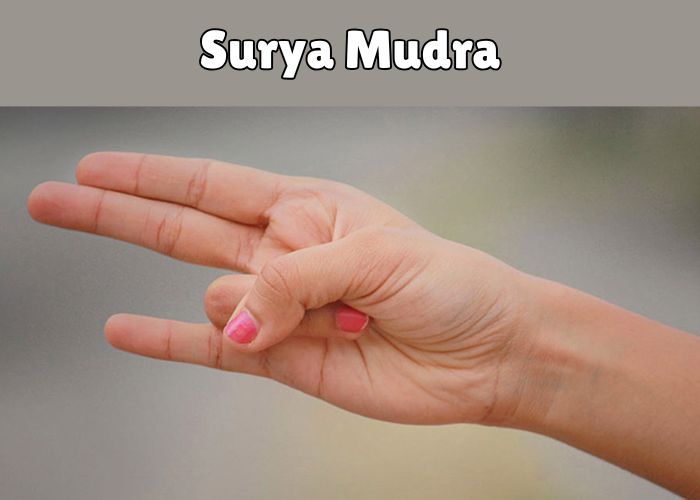
How to Do Surya Mudra of Yoga?
- Bend your ring finger and press it gently with the base of your thumb.
- Keep the other fingers straight.
- Practice with both hands while seated comfortably.
Benefits of Surya Mudra
- Enhances metabolism
- Aids in weight loss
- Reduces lethargy
- Improves digestive fire (Agni)
This is one of the different yoga mudras used for stimulating the fire element in the body.
5. Apana Mudra (Mudra of Elimination)
Apana refers to the downward flow of energy responsible for elimination and detoxification.
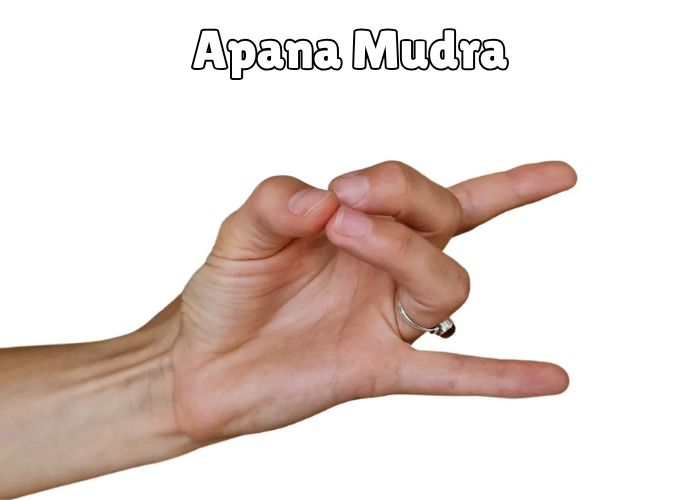
How to Do Apana Mudra of Yoga?
- Join the tips of the thumb, middle, and ring fingers.
- Keep the other two fingers extended.
- Practice while seated, ideally on an empty stomach.
Benefits of Apana Mudra
- Aids in digestion and elimination
- Relieves constipation and bloating
- Balances the excretory system
- Detoxifies the body
Practicing this yoga mudra for lungs and digestion supports internal cleansing.
Check the best mudras for meditation.
6. Vayu Mudra (Mudra of Air Element)
Vayu represents air. This mudra helps control excess air and is especially useful for joint pain and anxiety.
How to Do Vayu Mudra of Yoga?
- Bend your index finger and press it gently with the base of your thumb.
- Keep the other fingers straight and relaxed.
Benefits of Vayu Mudra
- Relieves gas and bloating
- Eases joint and rheumatic pain
- Reduces restlessness and nervousness
- Calms anxious thoughts
It’s a helpful yoga mudra for neck and shoulder pain as it soothes nervous energy stored in these areas.
Know about the top benefits of yoga.
7. Dhyana Mudra (Mudra of Meditation)
Dhyana means deep meditation or contemplation. This mudra is used for centering the mind and achieving inner stillness.
How to Do Dhyana Mudra?
- Place your right hand over your left hand, both palms facing upward.
- Touch the tips of your thumbs together forming a triangle.
- Rest your hands on your lap while meditating.
Benefits of Dhyana Mudra
- Deepens meditation
- Improves mental clarity and calmness
- Balances thoughts and emotions
- Aligns with higher states of consciousness
This is one of the kundalini yoga mudras used during long meditative sessions and breathing practices.
8. Hridaya Mudra (Mudra of the Heart)
Hridaya means heart. This mudra helps release emotional stress and supports cardiovascular health.
How to Do Hridaya Mudra of Yoga?
- Place the tip of the index finger at the base of the thumb.
- Join the tips of the middle and ring fingers with the tip of the thumb.
- Keep the little finger straight.
Benefits of Hridaya Mudra
- Relieves emotional stress and grief
- Supports heart function and circulation
- Calms the nervous system
- Opens the heart chakra
This is one of the good yoga mudras for heart health and emotional healing.
9. Anjali Mudra (Mudra of Reverence)
Also known as the “prayer pose,” Anjali means offering. It symbolizes gratitude, balance, and unity.
How to Do Anjali Mudra of Yoga?
- Bring your palms together in front of your chest in a prayer position.
- Keep the spine erect and eyes gently closed.
Benefits of Anjali Mudra
- Enhances emotional balance
- Promotes inner peace and gratitude
- Harmonizes left and right hemispheres of the brain
- Grounding and centering
It is among the important yoga mudras used in both practice and spiritual rituals.
10. Shunya Mudra (Mudra of Emptiness)
Shunya means space or emptiness. This mudra is helpful for ear and head-related issues.
How to Do Shunya Mudra of Yoga?
- Bend your middle finger and press it with the base of your thumb.
- Keep other fingers relaxed and extended.
Benefits of Shunya Mudra
- Helps with earaches and vertigo
- Reduces numbness and imbalance
- Brings inner calm and lightness
It is one of the most common yoga mudras used to reduce ether element disturbances.
Know about the top Spiritual Symbols With Meaning.
When and How Often to Practice Yoga Mudras?
Yogic hand mudras can be practiced almost anytime, but their effectiveness increases when done mindfully and consistently.
Best Time to Practice Yoga Hand Mudras
- Early Morning (Brahma Muhurta): Ideal for meditation-related mudras like Gyan or Dhyana Mudra, as the mind is calm and receptive.
- After Yoga or Pranayama: Practicing mudras after asanas or breathing exercises like Anulom Vilom enhances energy circulation.
- Before Sleep: Gentle mudras like Varun or Shunya are wonderful yoga mudras for sleep, helping calm the nervous system.
- During Meditation or Chanting: Mudras amplify the inward journey and help maintain focus.
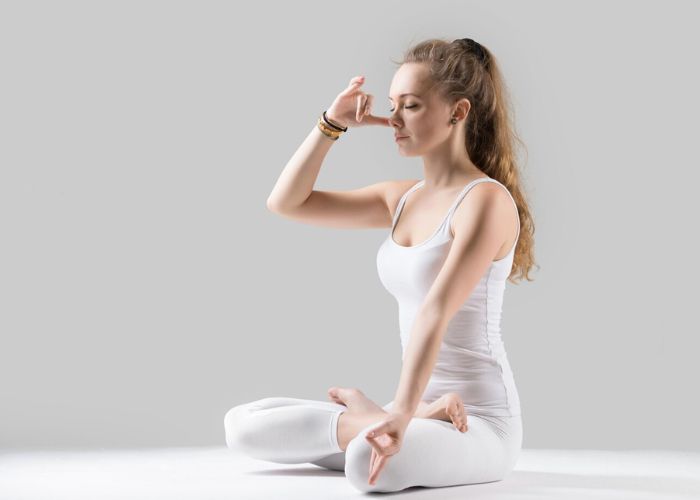
Duration for Yoga Mudras
- Start with 10–15 minutes per session.
- Gradually increase to 30–45 minutes, either in one sitting or divided throughout the day.
- Some therapeutic mudras (like Vayu or Apana) can be done 2–3 times daily, especially for targeted healing.
How Often to Practice Yogic Hand Mudras?
- For general wellness, practice daily.
- For specific issues (like digestion, anxiety, or pain), do consistently for 3–6 weeks for noticeable results.
- Mudras can be practiced even while walking, sitting, or lying down—as long as you remain mindful and comfortable.
Connection Between Yoga Mudras and Chakras
Yoga chakras are energy centers located along the spine that govern physical, emotional, and spiritual well-being. Each chakra corresponds to a specific element, organ system, and state of consciousness. Mudras, especially the hand mudras of yoga, act as subtle energy seals that help awaken, balance, and align these chakras.
Mudras work by directing prana (life force) toward particular chakras through energetic pathways called nadis. When practiced with awareness, breathing, and meditation, they gently stimulate the chakra system—removing blockages and encouraging natural energy flow.
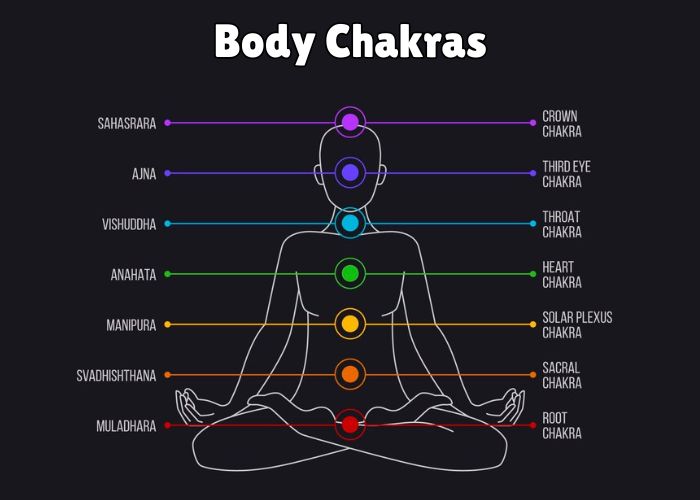
| Mudra | Chakra Activated | Element | Effect |
| Gyan Mudra | Crown Chakra (Sahasrara) | Space (Akasha) | Enhances focus, wisdom, and spiritual growth |
| Prana Mudra | Heart & Muladhara (root) Chakras | Earth & Air | Increases vitality and emotional strength |
| Apana Mudra | Sacral Chakra (Swadhisthana) | Water | Aids elimination and reproductive health |
| Surya Mudra | Solar Plexus (Manipura) | Fire | Boosts digestion, willpower, and confidence |
| Hridaya Mudra | Heart Chakra (Anahata) | Air | Releases grief and supports emotional healing |
| Varun Mudra | Sacral Chakra | Water | Promotes fluid balance and skin health |
| Dhyana Mudra | All Chakras (especially 6th & 7th) | Ether | Brings deep inner stillness and clarity |
FAQs About Mudras of Yoga
Some of the most common yoga mudras include Gyan Mudra (for focus), Prana Mudra (for energy), and Anjali Mudra (for balance and gratitude).
Yes, yoga mudras are safe for people of all ages and fitness levels. They require no physical exertion and can even be done while seated or lying down.
No flexibility is needed. Since mudras mainly involve finger and hand movements, they’re accessible to everyone.
Yes. Many hand mudras can be practiced discreetly while doing everyday activities like walking, reading, or working.
Hand mudras help reduce stress, enhance focus, improve sleep, support digestion, and balance emotional energy.
Yes. Varun Mudra, Shunya Mudra, and Dhyana Mudra are popular yoga mudras for sleep, promoting relaxation and calming the mind.
Prana Mudra is known to activate vital energy and enhance vitality. It is often used in kundalini yoga mudras to awaken dormant energy.
Yes. Vayu Mudra and Gyan Mudra are particularly helpful for calming the nervous system and reducing anxious thoughts.
Absolutely. Each mudra corresponds to different chakras, helping stimulate and align energy centers when used with breath and awareness.
Finger mudras are yoga hand gestures that involve touching specific fingers to redirect energy, based on the five elements each finger represents.
Apana Mudra and Surya Mudra are especially helpful for supporting digestion, elimination, and metabolism.
Yes. Hridaya Mudra is one of the good yoga mudras for heart health, as it supports emotional balance and cardiovascular well-being.
Apana Vayu Mudra and Prana Mudra are beneficial yoga mudras for lungs, enhancing oxygen flow and respiratory health.
Yes. Vayu Mudra can help relieve stiffness and tension, making it a gentle yoga mudra for neck and shoulder pain relief.
Yes. Many mudras have spiritual significance and are used to deepen awareness, balance chakras, and awaken inner energy in meditation.
Yes, children can benefit from mudras like Gyan and Prana for focus, energy, and emotional calmness. Supervision is suggested for younger kids.
Mudras are subtle energy gestures (mostly with hands), while asanas are physical body postures. Both complement each other in yoga practice.


